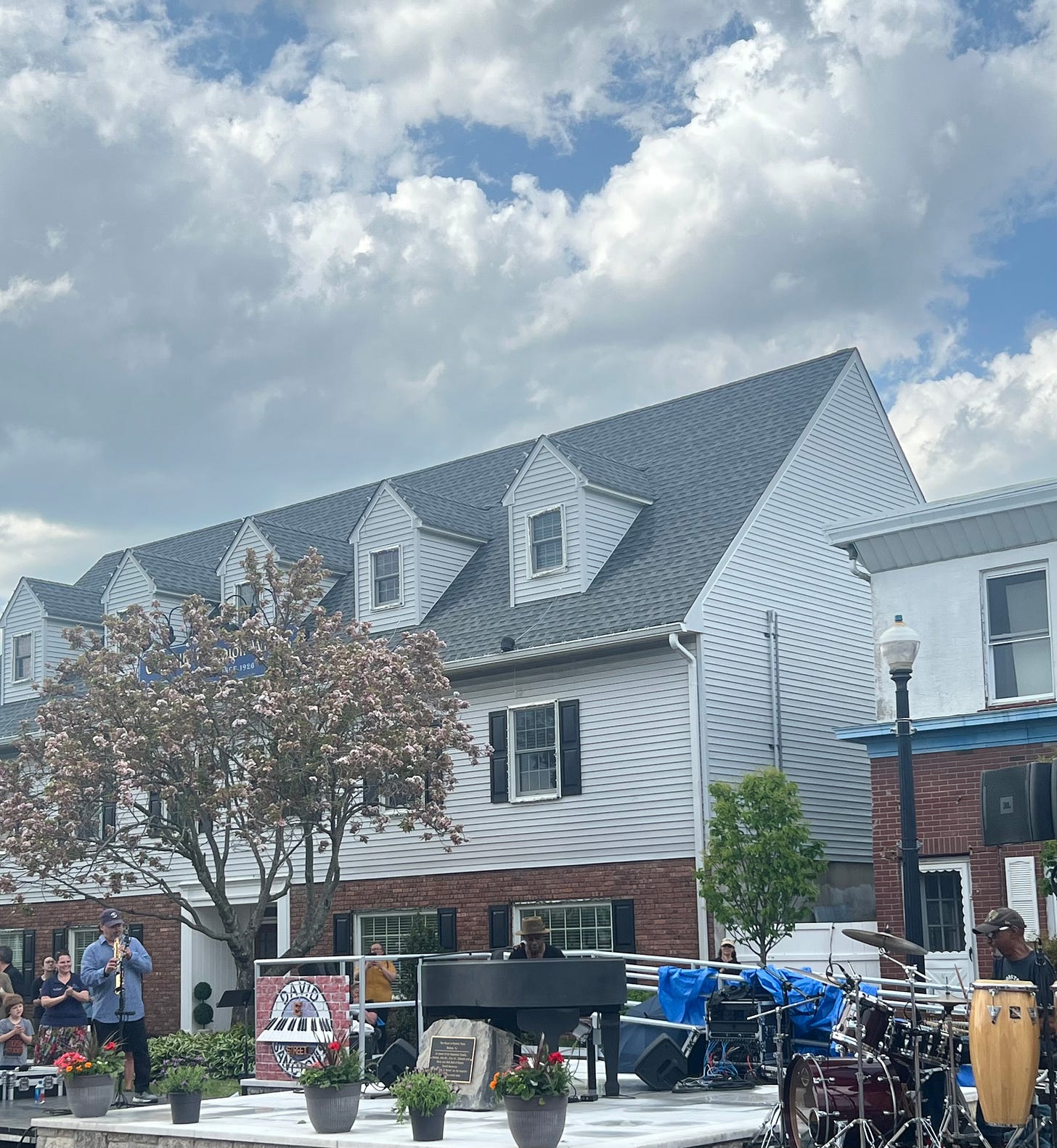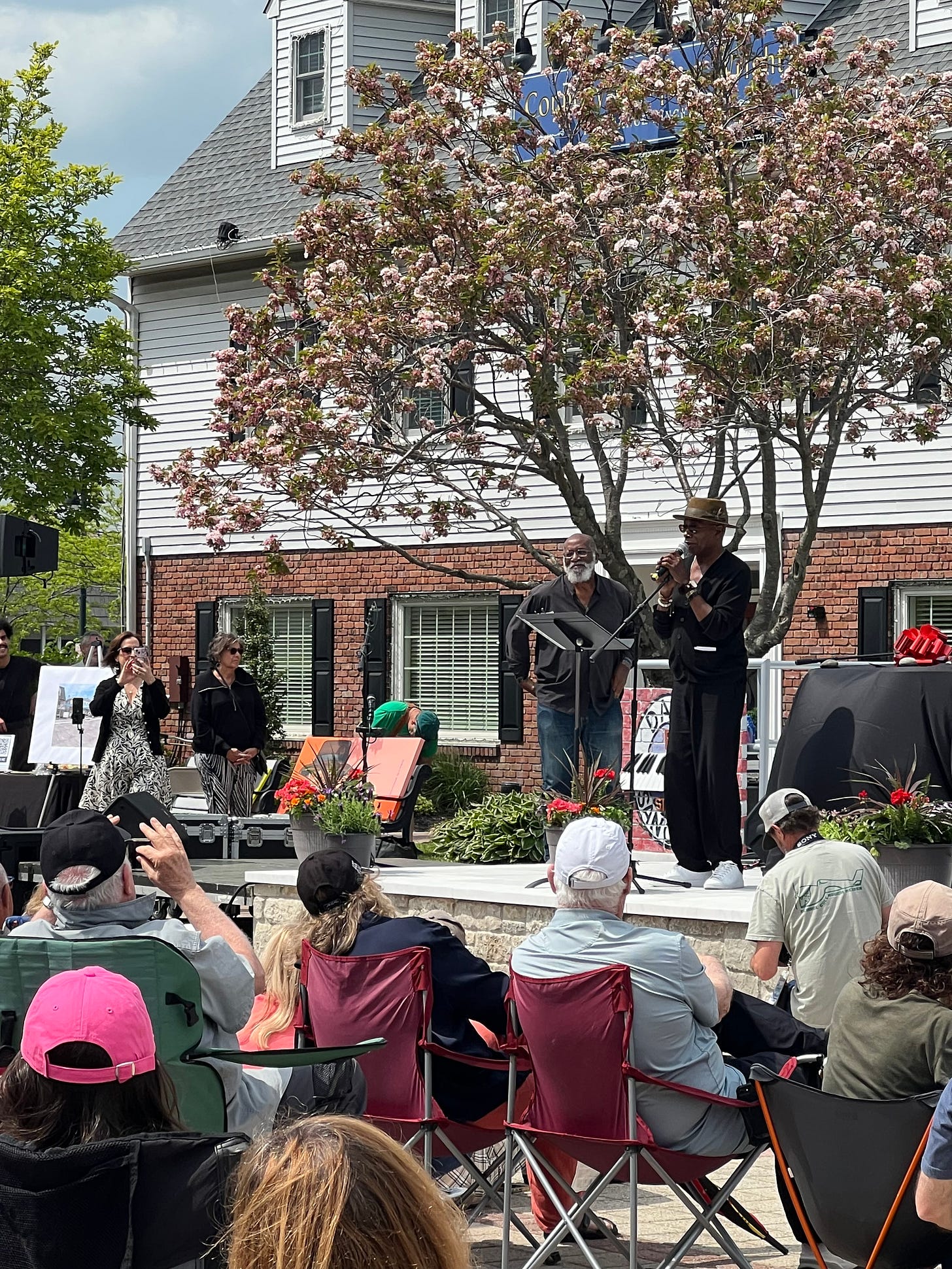David and Stelma Sancious Honored in Belmar, NJ
Virtuoso Multi-instrumentalist and His Late Mother Recognized in Hometown with Dedication of a Piano
David Sancious is one of today’s most remarkable and important musicians.
Born in Asbury Park, NJ, in 1953, his mother, Stelma, moved the family to nearby Belmar when he was a child. As David recalled in Belmar yesterday, the previous owner of their new Belmar home left a piano in it, which his mother shortly thereafter began playing. David and his brothers did not know their mother played, but soon enough, David was learning to play on it as well. A school guidance counselor, Stelma was an advocate of music and arts education in the community and was surely pleased with her son’s newfound interest in the instrument left behind in their home. Before long, David met the leader of a band named Steel Mill: Bruce Springsteen. While local to Monmouth County, Steel Mill had a following in Richmond, Virginia and had attracted attention in Northern California, but Springsteen wanted to move on. Steel Mill’s guitarist and main songwriter wanted to disband the hard rock band with progressive rock influences and start a new band that accentuated his soul and rhythm-and-blues influences, and he invited David Sancious to play keyboards in it. The Bruce Springsteen Band eventually morphed into Bruce Springsteen and the E Street Band, named because the band rehearsed in the Sancious’ Belmar home on E Street. David Sancious played on Springsteen’s first two albums, Greetings From Asbury Park, NJ and The Wild, the Innocent and the E Street Shuffle (both 1973) and perhaps his most famous song, “Born to Run”. Sancious’s influence is particularly noticeable on the second album, which many fans and critics regard as his greatest. David’s classical and jazz influences helped shape Springsteen’s most epic and musical album. While one B. Springsteen is the only credited composer, tunes like “New York City Serenade” would sound significantly different, emptier and lighter without the skill and touch of David Sancious (just listen to the introduction). As Springsteen’s music became simpler and more compact, turning ever more away from his progressive rock influences, Sancious and drummer Ernest “Boom” Carter left to form jazz fusion band Tone, but not before recording “Born to Run” on August 6, 1974, a few weeks before their departure. Sancious would also play on Springsteen’s Human Touch (1992) and Western Stars (2019).
Springsteen tried to talk Sancious and Carter out of leaving, and the above would be accomplishment enough for the two. But Sancious had aspirations of his own that clashed with the simplifying trends of modern times. He mastered guitar as well, playing keys and guitar with Carter in their jazz fusion band Tone, and launched a distinguished career as a solo artist, sideman, and one of the most in-demand session players in the music industry. In addition to Tone and solo piano albums like The Bridge (1982), he played with Peter Gabriel at the height of Gabriel’s commercial success. [Edit/correction: He did not play on Gabriel’s So. He played on the So Tour and other tours.]
Yesterday, Belmar honored David and Stelma Sancious (who died in 1997) with a ceremony and a dedication of a weather-proof piano to him (if it will weather New Jersey storms, it is quite a piano indeed). The ceremony took place in Pyanoe Plaza, the home of the new piano, which is named after former Belmar mayor Francis Pyanoe. Local leaders, including current mayor Gerald Buccafusco, spoke about the two-year process of acquiring and preparing the piano, the second of its kind installed in the United States, and plans for it to be the centerpiece of future holiday celebrations. Buccafusco stressed that the piano would be available for all “Belmartians” and visitors to play, regardless of their skill level. After these preliminary remarks, David Sancious and his brother Edward remembered their mother. David cut a ceremonial ribbon, and he sat down at the piano, beginning an informal and appropriately extemporaneous set showcasing his myriad influences and his improvisational, musical, and entertaining approach.
David recalled being approached between sets of an E Street Band residency at The Bottom Line in New York by an artist and repertoire representative, which led to the Tone recording sessions and his solo career. The A&R man stressed that the label would be artist-centric. The label was likely Elektra Musician, which released The Bridge in 1982, a time when artist-centric labels were still culturally and commercially viable. David then performed “Sleight of Hand” from The Bridge before a sudden downpour inspired an ad hoc intermission. (Monmouth County, New Jersey needs a weather-proof piano. Here, if you don’t like the weather, wait twenty minutes. If you like it, don’t make plans.)
Eventually, the rain subsided, and Sancious returned with Carter and soprano saxophonist Tommy La Bella, playing both composed pieces and improvisations as well as reminiscing about his youth in Belmar and nearby Manasquan High School. The dignified, soft-spoken Sancious, who could be difficult to hear, told the audience that, at that time, Belmar residents could choose to attend either Manasquan or Asbury Park High School. He described himself as shy and somewhat quiet and thought that he would prefer Manasquan to what he perceived as the more dangerous Asbury Park, where he would be constantly defending himself. The trio performed David Sancious & Tone’s “Prelude # 3” (from 1978’s True Stories), which David introduced as exemplary of the classical harmony he was studying while attending Manasquan High, accentuated by funk.

Following the Tone tune, David remembered his frequent truancy during his Manasquan High days, recalling listening to the first Led Zeppelin album in 1969 in a house in Manasquan while skipping school and ingesting drugs. There was an irony that was not lost on me as the musician, being honored by local officials and civic leaders, spoke about truancy and use of drugs, some of which are unfortunately still illegal. That day, David was apprehended by police and returned to school. During this anecdote, a passing motorist yelled, “GO TRUMP!” Sancious responded in his quiet, laconic, dignified manner, with a gentle,“Bite me”, to the approval of many in the audience, diffusing any tension. He continued that he spent much of his time cutting class dedicated to more productive, constructive endeavors, learning and playing sonorous classical pieces by the likes of Beethoven and Brahms. (The world is a better place now due to his truancy.) Unfortunately, his mastery of the pieces was so distinctive neighbors would report him when they heard his playing during school days. This necessitated his toning down his playing during school hours into “soft improvisations”, and he demonstrated with an example effectively.
Sancious then spoke of his jazz influences, and the trio performed a jazz improvisation in E minor. Underscoring his countless influences, he then talked about Jimi Hendrix, prefacing a performance of The Jimi Hendrix Experience’s “Third Stone from the Sun”, one of Sancious’s favorites, with a discussion about harmony. He said that if one uses harmony correctly, players can change the tone of a piece without changing the melody. The trio then essayed what David called their “re-harmonized version” of the Hendrix composition.
There were some final remarks, including a brief mention of Sancioius’s current tour with Living Colour’s Will Calhoun. Sancious, Carter, and La Bella then ended the pleasant afternoon with one more example of Sancious’s diverse influences, a spontaneous gospel piece, the pianist asking the audience to clap along in time.
It is almost tempting to be reductive describing David Sancious’s style as some kind of simple hybrid of Frederic Chopin, Count Basie (also from Monmouth County), and Jimi Hendrix, three pioneers of the big three genres of music, but that is not fair to him, and that style, as his set yesterday demonstrated, is richer and unique. His guitar playing is closer to jazz greats like John McLaughlin, but his playing on multiple instruments is a singular style all his own. He comes from a generation when musical skill and knowledge was still almost necessary to be successful (now it is practically a liability for his kind of success), and he steered his career in a thoughtful, sophisticated, musical direction when the broader culture became more thoughtless, gormless, and noisy. His awareness and appreciation of musical history infused depth in his own music and that of some of the most prominent and significant songwriters and artists of our time. It is salient and appropriate that David Sancious and Tone made an album titled Dance of The Age of Enlightenment, as they brought the sensuous sensibility and enlightenment of the most glorious age of human achievement during our time—the Age of Enlightenment’s dark, atavistic, subhuman antipode. Though he is not as recognized as he deserves, David Sancious’s playing has been heard and celebrated around the world. Yesterday in his hometown, in an afternoon both entertaining and informative, he demonstrated to an appreciative crowd that, in an ever more artless culture, artists still exist. And he is one of the reasons Monmouth County’s music scene still thrives.






